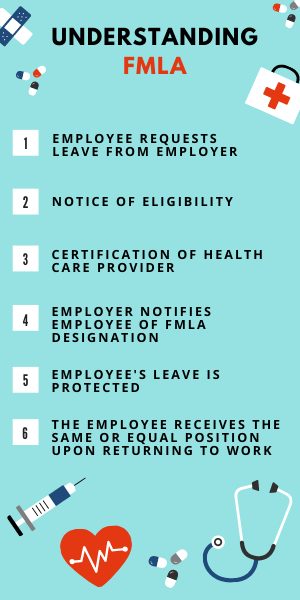FMLA certification guide for employers

The Family and Medical Leave Act (FMLA) is one of the most commonly requested forms of employee leave. It provides job-protected leave for employees who need time off due to a serious health condition, additions to the family (through childbirth, adoption, or foster care), or to care for a family member with a serious health condition. It’s an important protection for employees, but managing leave requests and obtaining FMLA certification can be a confusing process for employers.
If you’re not quite sure how to handle an employee’s FMLA request or you’re wondering how you can verify their eligibility for medical leave under the FMLA, keep reading to learn more about FMLA certification.
What is FMLA certification?
FMLA certification is the process of verifying and certifying an employee’s eligibility for FMLA leave. It typically involves reviewing documentation from a medical professional verifying that the employee or an immediate family member possesses a serious health condition requiring FMLA leave.
What documentation can be requested for FMLA certification?
Any time that an employee requests FMLA leave, the employer can request that the employee provides FMLA certification documentation from a healthcare provider. The Department of Labor has templates available for the certification of an employee’s serious health condition (form wh-380-e) and the certification of a family member’s serious health condition (form wh-380-f).
These forms include information on the expected duration of the condition, dates of scheduled treatment, and the employee’s incapacity as it relates to their essential job functions. One thing that is noticeably absent from the form is a diagnosis. There may be some mention of required treatments or specialists that they are seeing that may provide some context clues, but employees do not need to disclose their specific serious health condition in order to complete FMLA certification and employers should respect the employee’s privacy.
The DOL rules also stress that the status of a healthcare provider isn’t limited to physicians. A provider is defined as a doctor of medicine or osteopathy authorized to practice medicine or surgery in a specific state or any other person whom the Secretary of Labor deems capable of providing health care services.
Here’s a partial list of those who are considered healthcare providers:
-
Physicians
-
Podiatrists
-
Optometrists
-
Nurses
-
Dentists
-
Clinical Psychologists
-
Chiropractors
-
Clinical Social Workers
-
Christian Science practitioners
-
Other healthcare providers recognized by the employer or the benefits manager of the employer’s group health plan such as acupuncturists, nutritionists, and massage therapists.
There are instances where medical certification may not be applicable, such as military family leave. In these instances, employers can still request certification in the form of documentation verifying the need for military family leave for a qualifying exigency.
Similarly, employees do not need medical certification of their need for leave to bond with a new child. They may show a birth certificate or adoption/placement documentation to verify the existence of the child and that they are still within the one-year eligibility timeline for FMLA leave to bond with a child, but full medical certification should not be requested. Pregnancy can count as a serious health condition and medical certification can be requested if an employee requests time off due to pregnancy or to recover from childbirth.
FMLA medical certification timeline for employers
Here are the standard steps in the FMLA certification process for an employer.
Receive the FMLA leave request or otherwise become aware of an employee’s need for FMLA
The process starts when employers either receive an FMLA request from an employee or become aware that an employee may qualify for and require FMLA leave.
At this time, you’ll need to verify that you are considered a covered employer and verify the employee’s eligibility. Per FMLA regulations, a covered employer is one who employs 50 or more employees within a 75-mile radius of the employee’s worksite.
 Employees also have some eligibility guidelines to meet. In general, employees are eligible for FMLA leave if they:
Employees also have some eligibility guidelines to meet. In general, employees are eligible for FMLA leave if they:
-
Work for a covered employer.
-
Have worked for their current employer for 12 months.
-
Have clocked at least 1,250 hours over the past 12 months.
-
Work at or report to a worksite with at least 50 employees within a 75-mile radius (for remote staff, the worksite that they report to is whatever office they receive the majority of their assignments from).
-
Have a qualifying reason for FMLA leave.
Provide an eligibility notice
Within five business days of becoming aware of an employee’s potential eligibility for FMLA leave, the employer must provide an eligibility notice. At this stage, the eligibility determination is simply about whether the employee meets the basic eligibility criteria. The eligibility notice is not making a determination of whether or not the leave will be granted as the final determination will be made after medical certification is provided by a healthcare provider.
Request certification
This is the step where employers can request medical certification to verify the need for FMLA leave. Employers can fill out the first section of the applicable DOL medical certification form and provide a deadline for returning the form. Employers do need to give employees and their health providers at least 15 calendar days to complete and return the paperwork. The employee’s healthcare provider can then complete the rest of the form.
Review the documentation provided
Once an employer has received the certification form back from the employee or the employee’s healthcare provider, it is time to review it to verify that the health condition qualifies as a serious medical condition. Again, the employer is not entitled to the employee or their family member’s full medical records and may or may not be provided with the specific diagnosis. As such, employers are typically reviewing the certification form for completeness as well as clarity on the employee’s needs and limitations.
One key thing to look at is whether an expected end date or duration was provided. Providers should give it their best estimate rather than writing vague things like “unknown” or “forever”. Employers will also want to verify that the provider statements detailing why the employee needs time off are clear. They should be explaining what the employee will be doing for their sick family member or how their own serious health condition will make them unable to perform at least one of their essential job functions.
Sometimes employers will need to contact the employee and ask them to obtain additional information from their health provider. Employers should not contact the provider directly for additional information beyond what was written on the form, though simply verifying the authenticity of the document and trouble-shooting messy handwriting is generally allowed.
Employers can request a second opinion or additional information to confirm the employee’s need for the requested leave if the initial documentation did not provide enough information or if something was unclear. Requests for second opinions must be made in good faith and only when the employer has reason to doubt the validity of the initial certification.
Give the employee a designation notice
Once the employer has reviewed all of the provided documentation, they can move on to the last step of the FMLA certification process and send out a designation notice to the employee. This notice must be provided to the employee within five business days of receiving their medical certification.
The designation is essentially just a letter letting the employee know whether or not their FMLA leave request was approved. The designation can also be used to request additional information if needed, and should include a deadline for receipt of any additional documents or information requested.
Employee takes protected leave
Once this step is complete and leave has been formally approved, the employees can take their leave as scheduled. This may be the end of the FMLA certification process unless recertification is requested.
Recertification
Employers can request recertification to verify the employee’s need for continued leave. According to the Department of Labor (DOL) an employer may request recertification no more than every 30 days, unless specific criteria are met. Instances where employers may request recertification early or more frequently include if the condition of the employee or the employee’s family member has changed significantly, a leave extension is requested, or the employer has received information that casts doubt on the validity of the employee’s eligibility for FMLA leave.
If the original medical certification form completed by the employee’s healthcare provider indicated that the minimum duration of the condition is greater than 30 days but less than six months, the employer will need to wait until the listed minimum duration expires before requesting recertification. For example, if a healthcare provider writes that an employee will not be healthy enough to return to work for at least 90 days after experiencing some form of serious injury or illness, an employer should not request recertification until the full 90 days have elapsed.
In all instances, including those where the listed minimum duration extends beyond six months, employers may request recertification every six months as long as it is in connection to an absence. If an employee has returned to work and they are not requesting additional leave outside of standard PTO usage, employers should not request recertification or inquire about the status of an employee’s medical condition unless it is strictly related to any requested ADA accommodations.
If an employee does not provide sufficient certification documentation in a timely manner after recertification is requested, the employer may deny continuation of the FMLA leave protections until the employee provides the necessary verification. It’s also worth noting that second and third opinions may be requested in the initial FMLA certification process, but they cannot be requested for recertification.
FMLA certification storage
There’s a lot of paperwork involved in the FMLA certification process. Lots of notices and requests will be going back and forth between the employer and employee along with medical certification forms.
Employers are generally directed to store medical information separately from an employee’s normal personnel records, so employers should be extra careful in handling and storing FMLA paperwork properly. Certification forms, recertification forms, and any documents that contain any medical information should be stored securely and separately and should only be accessed by human resources or others that need to review the documents to determine FMLA eligibility.







